If you’re a student, you probably know how to write a good essay. But what if you need a little assistance with a tricky task? Well, in that case, you can use AI tools like ChatGPT to find inspiration, decide on the paper’s structure, and create model samples.
When you use the chatbot this way, there’s one thing you need to remember – the prompt is everything. The quality of the tool’s responses directly depends on how good your prompt is, so you need to be smart about it.
How? Read this article to find out!
Here, our experts will:
- Share the best ChatGPT prompts for essay writing,
- Discuss what to avoid when you use AI for academic assistance,
- Explain how to make the chatbot write an essay of any type.
✍️ ChatGPT’s Essay Writing Capabilities
First, let’s talk about ChatGPT’s capabilities and how it can help you write a great essay.
The chatbot is generally used for various language-related tasks such as translating, summarizing, or creating text. Its ability to generate fluent and well-written content makes it popular among students.
But why is ChatGPT so good at writing?
Well, it’s designed to understand and process natural language. The chatbot is trained on huge amounts of data and is capable of recognizing words and grammar patterns. All this allows the algorithm to analyze the prompt and generate natural-sounding, coherent responses.
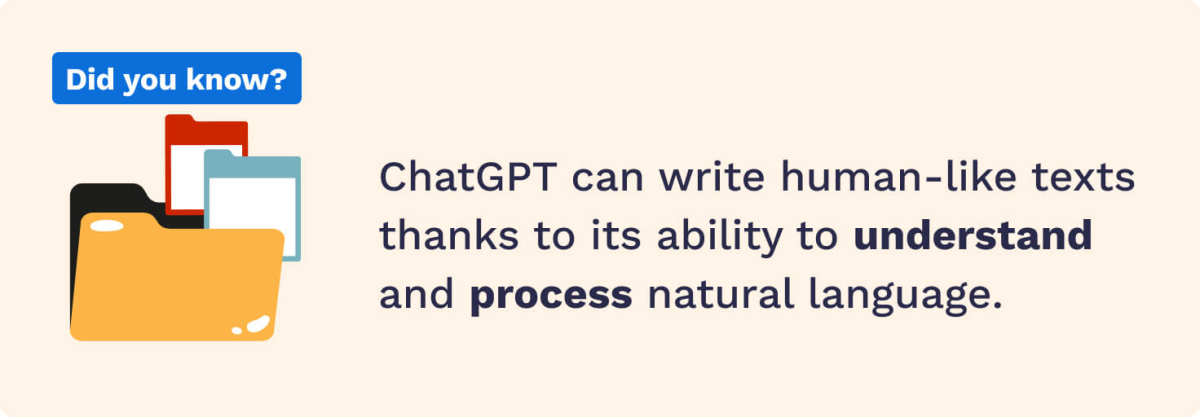
Essays created by ChatGPT are also well-structured. Their introductions contain catchy hooks and clear thesis statements, while each paragraph has a topic sentence and linkers.
All this makes the chatbot a great academic writing assistant.
Can ChatGPT Write an Essay with References?
One of the most common mistakes students make while working with ChatGPT is using it to create references.
Well, that’s a terrible idea.
Despite being an advanced AI tool with an extensive database, the chatbot can’t cite real sources. And what’s worse, it tends to come up with nonexistent citations and pretend they’re real.
Here’s an example of what the generated references may look like:
A quick fact-check will show that none of these articles actually exist. They even look suspicious, with names repeating and one person named “Fluorescence.”
If you ask the chatbot about them, here’s what it will have to say:
Trust us: you shouldn’t take everything the chatbot produces at face value and delegate every single aspect of essay writing to it.
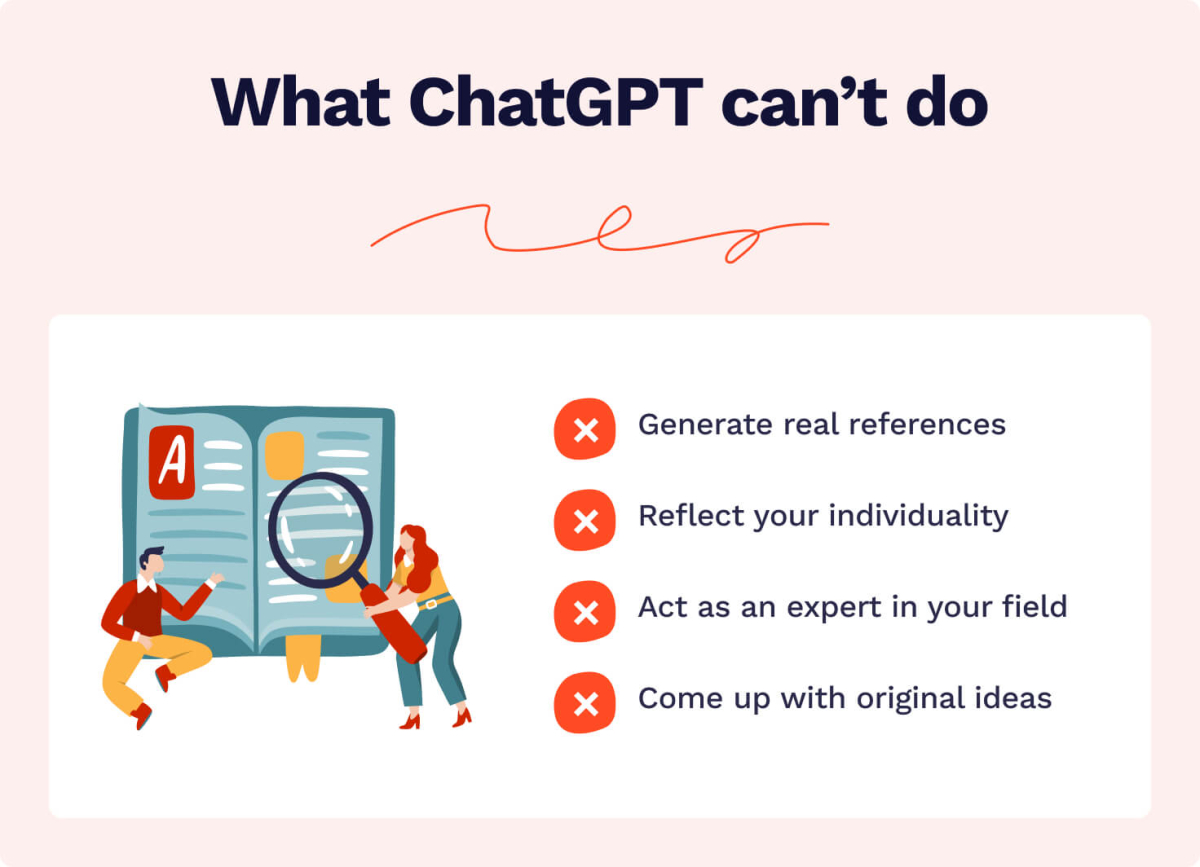
What Else ChatGPT Can’t Do
Aside from fake citations, the chatbot has many other limitations and cons that you should know about:
- Biased answers and information. Because ChatGPT was trained on internet data, it may give prejudiced responses on controversial topics.
- Lack of individuality. While texts created by the chatbot sound human-like, they are still artificially generated by combining cliché patterns and trite ideas.
- Limited knowledge of subjects. ChatGPT’s database is enormous, but the tool still lacks genuine expertise in niche or fast-evolving academic fields.
- No knowledge of recent events. The chatbot is also limited by the date of its latest update (January 2022,) so it might not have all the up-to-date information on the subject.
- Unreadable texts. Whenever ChatGPT tries to write a formal text, it makes it overly lengthy and redundant. The repetition of difficult words and complex sentences makes such texts hard to comprehend.
- Lack of originality. While ChatGPT’s responses sound original, they’re actually derivative since the tool rehashes existing texts to create them. For that reason, using AI to generate academic papers is considered cheating.
Stealing ideas from copyrighted texts is not the only ethical issue with AI usage – keep reading to learn more about them.
⚖️ Ethical Issues with ChatGPT Essays
One essential aspect of using ChatGPT in your studies is that, in most cases, it’s seen as an unethical practice. There are many reasons for that, such as:
- Lack of real effort from the student,
- Unfair advantage over those who write their assignments themselves,
- No attribution to the text’s original author,
- Presence of made-up facts and false statistics.
Of course, there are ways to use the chatbot ethically but many students choose to ignore them and generate entire paragraphs or even essays. This is seen as academic dishonesty and can have serious consequences, from failing a class to getting expelled.
The fluency of AI texts can trick people into believing they won’t be caught if they submit a generated paper. The truth is, there are plenty of advanced AI-detecting tools that can identify texts written by ChatGPT. Even if you paraphrase every sentence of the essay, it doesn’t mean you won’t get caught cheating.
🤔 So, Should You Generate Essays with ChatGPT?
At this point, you may be wondering if creating essays with ChatGPT is even worth it.
Well, it is if you do it the right way.
Artificial intelligence can indeed create well-written texts, but it doesn’t mean you can copy and submit them as your own. This practice won’t get you an A+ or make you smarter. It will only put you at risk of being punished or even expelled from school.
But there’s another way of using ChatGPT that is both safe and beneficial. You can freely use the chatbot as an assistant and a source of inspiration for writing your own paper. This way, you’ll make the writing process easier and get an authentic, high-quality text in the end.
All you need is the correct prompts. Without them, you will get irrelevant results that won’t be of any help. In contrast, a well-written prompt will help you get exactly what you need.
Want to know how to develop the best possible prompts? Keep reading!
🚀 How to Use ChatGPT to Write an Essay in 5 Steps
To get the best out of AI-assisted essay writing process, follow the five steps:
In the following sections, we will tell you all about these steps and show you examples of effective prompts that you can use.
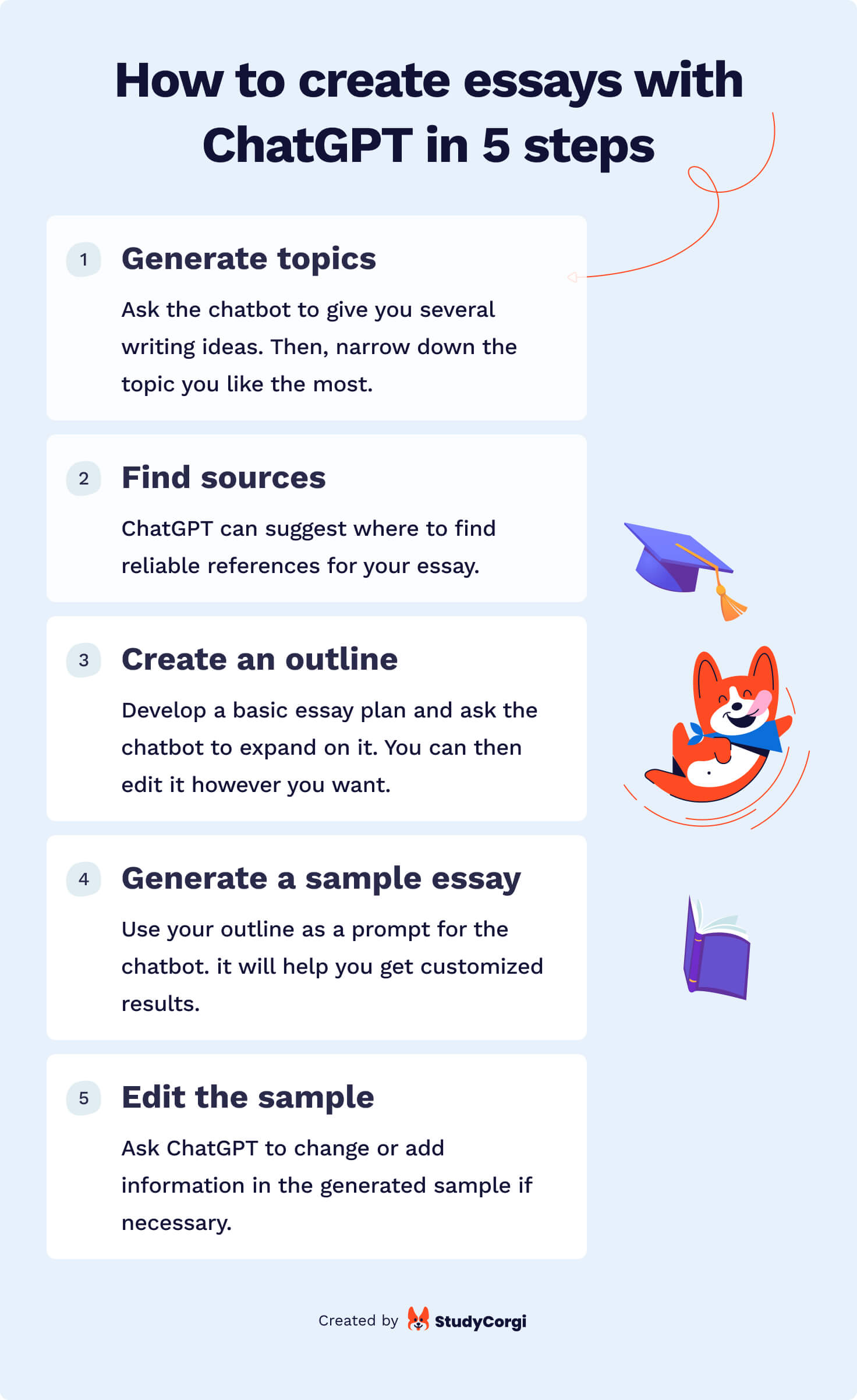
1. Ask ChatGPT to Generate Topics
If you were not assigned a specific topic for an essay, you can use AI to brainstorm ideas. For better results, give the bot as many details as possible, such as:
- the type of essay you need to write,
- the general subject you plan to write about,
- the academic level your essay should have.
You may also ask the tool to add descriptions to the generated topics. This will allow you to have a clear starting point for your research.
To get the best topic ideas, you can use prompts like these:
Now, you can choose the idea you like best and modify it however you wish.
2. Ask the Chatbot to Find Sources
After you’ve chosen a topic, the next step is to find suitable sources. ChatGPT can’t provide sources with links, so you’ll have to look for them on your own. However, the tool can still suggest the works you can study and use as references.
When creating a prompt, you can specify what kind of sources you need.
For instance:
These prompts will yield results including real titles of existing works.
Tip: What if you want to include a quotation from a source, but you’re not sure about its meaning? In that case, feel free to use our quote explainer.
3. Use AI to Create an Outline
Now, you have all the necessary information to create an outline. Structuring an essay is one of the most challenging tasks for students. If that’s the case with you, ChatGPT will once again come in handy.
To get a good outline, specify the number of words and the topic of your essay in your prompt. We also recommend mentioning the main aspects you want to discuss in your work.
Here are prompt examples you could use:
Now, all you need to do is write your own essay plan based on what you’ve generated.
We strongly discourage you from using AI-made outlines as is since they may contain irrelevant information or be too for your word count. For example, if you look at the 500-word smoking essay outline above, you will notice that the first body paragraph includes as many as six discussion points. There’s no way you’ll be able to review them all in 100 words.
Tip: Want to get a customized outline without having to write a detailed prompt? Try using our essay outline generator.
4. Generate a Sample Essay
After you finish your outline, you can finally use ChatGPT to create a sample essay. Remember that you should use the generated text as an inspiration only. Instead of copy-pasting the sample, use it as a blueprint to write your own paper.
The easiest way to get a great sample is to include the outline in your prompt and ask the tool to write an essay based on it. Describing the essay’s contents in detail will ensure that the generated text is exactly what you need it to be.
It’s also possible to use simpler prompts, such as these:
Keep in mind that if you choose to use simple prompts like the ones above, you can’t be so sure of the results and how relevant they will be. We recommend taking your time to develop an outline and then use it to generate a sample essay.
5. Change the Generated Essay
The last step is to edit and improve the sample. While ChatGPT is capable of generating a complete essay, it may miss important details or include parts that are irrelevant.
Luckily, you can add or remove information by continuing your conversation with the chatbot. Just explain the tool what changes you want to make.
Suppose ChatGPT didn’t discuss the importance of the relationship between co-workers in an essay about the workplace environment. To add this information to your paper, you can use a request like this:
We also recommend you highlight the part you want to edit and click the “reply” button that will appear. The selected text will be automatically quoted in your prompt. This way, you will give the tool a clear idea of what exactly you want it to change without copying and pasting anything.
And there you have it – a customized essay sample on your topic. Use it to compose your own paper, and make sure to add a personal twist to it.
Tip: Our AI-based tools will help you make your essay perfect:
- Is your text too short? Use an essay extender to make it longer.
- Checking your paper’s structure and flow will be easier with our “read my essay” tool.
- To ensure the final version of your paper has no traces of generated text, scan it with our Chat GPT essay detector.
📚 ChatGPT Prompts for Essay Writing: Different Genres
Now that you know how to create ChatGPT essay writing prompts, let’s focus on something more specific.
For instance, how do you develop prompts for different types of essays where you need to consider the nuances of the genre? Well, keep reading to find out!
In the sections below, we’ll explain what prompts will help you create top-notch narrative, descriptive, comparative, persuasive, and argumentative essays.
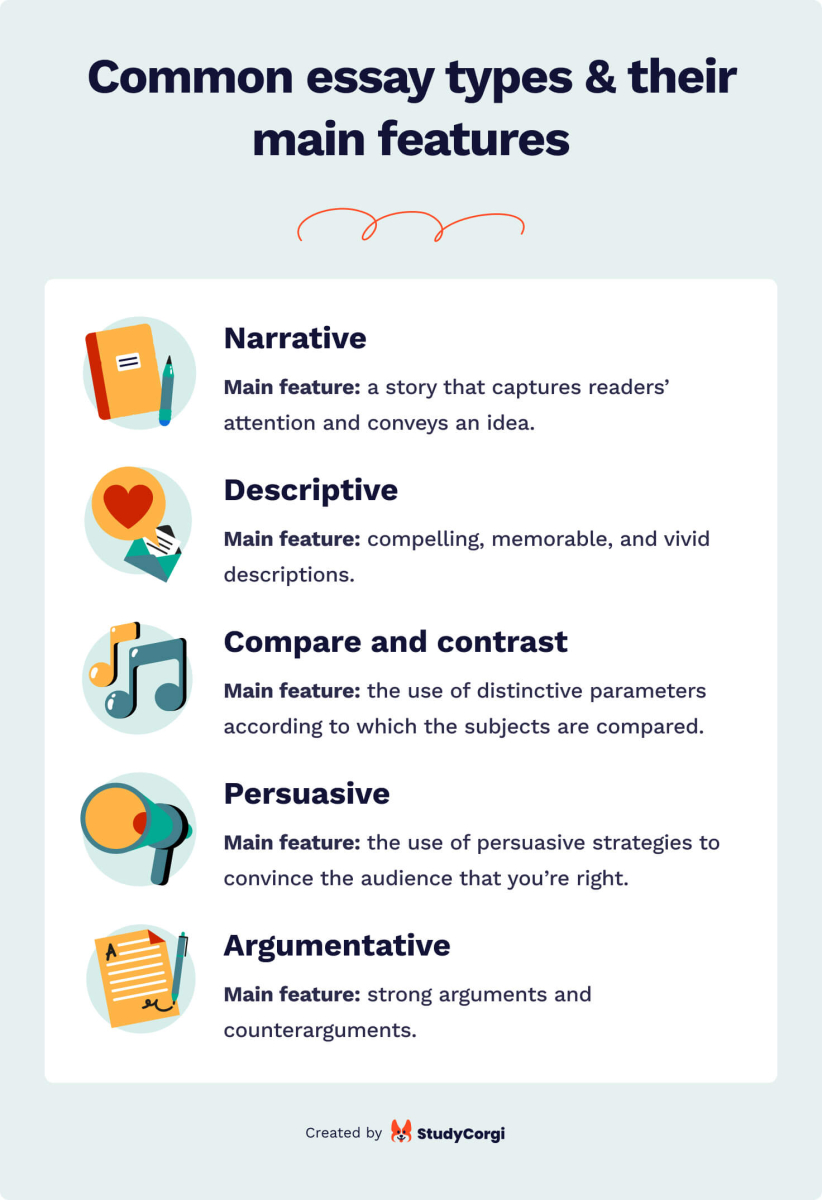
How to Get ChatGPT to Write a Narrative Essay
The main goal of a narrative essay is to capture readers’ attention with its story. That’s why a prompt for such an essay needs to include:
- Information about the readers,
- What the essay should be about,
- The aim of your paper.
Suppose you want to inspire your audience or convey a particular message. Here are two good examples of prompts that will help you achieve this:
Both of these prompts:
- Identify a paper’s intended audience (teenagers in the first one and graduate students in the second one.)
- Mention the narrative’s theme (passion as a cartographer and the importance of ethical leadership.)
- State the purpose of an essay (inspiring and teaching a lesson.)
How to Make ChatGPT Write a Descriptive Essay
Compelling and memorable descriptions are crucial when writing a descriptive essay. ChatGPT can help you with that, but there is one important thing you should keep in mind to get the best results.
If you simply ask the AI tool to write a descriptive essay on your topic, you’ll get an unreadable text filled with awkward metaphors and corny descriptions like this:
Example: As I wrap myself in the comforting embrace of the quilt, I am enveloped in a cocoon of emotions. Joy mingles with sorrow, nostalgia with longing, creating a bittersweet symphony that resonates deep within my soul. In this moment, I am not just reliving memories, but experiencing them anew, each stitch a thread connecting past and present, heart and soul.
Terrible, right?
What you need is a more natural-sounding sample. So, how can you achieve this?
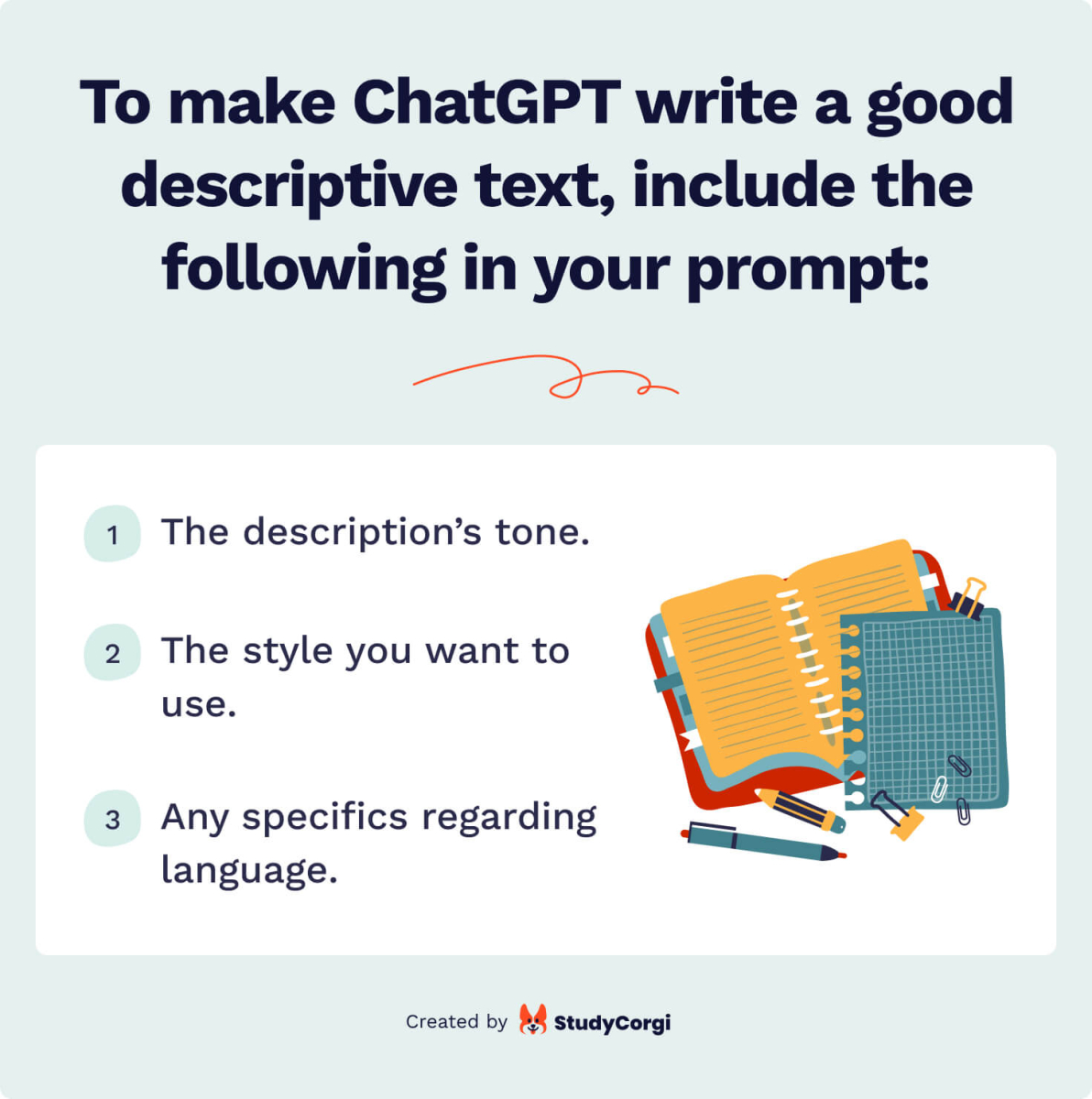
First, you need to choose a well-written descriptive fragment from a literary work you like. We chose this passage from Nabokov’s story “First Love”:
“In the early years of this century, a travel agency on Nevski Avenue displayed a three-foot-long model of an oak-brown international sleeping car. In delicate verisimilitude it completely outranked the painted tin of my clockwork trains. Unfortunately, it was not for sale. One could make out the blue upholstery inside, the embossed leather lining of the compartment walls, their polished panels, inset mirrors, tulip-shaped reading lamps, and other maddening details. Spacious windows alternated with narrower ones, single or geminate, and some of these were of frosted glass. In a few of the compartments, the beds had been made.”
Now, we will ask ChatGPT to point out the text’s distinctive features using a prompt like this:
After that, you can include the features ChatGPT described in your essay prompt. Here’s what it can look like:
The result will be a readable descriptive text that you can slightly improve and use as a foundation for your essay.
Tip: Any descriptive essay needs to open with a great attention grabber. Feel free to use our hook generator to develop a catchy opening sentence.
How to Prompt ChatGPT to Write a Compare and Contrast Essay
To write a comparative essay, you first need to identify the parameters according to which you’re comparing two or more things. ChatGPT can help you find them quickly and efficiently.
For instance, to compare fiction with non-fiction, you can use this prompt:
Now, you have your points of comparison: content and purpose. You can use this information to develop a brief outline and later use it in your prompt to generate an essay sample.
For a compare-and-contrast outline, specify what each part should cover:
- The introduction will include a thesis statement explaining the subjects’ similarities and differences.
- The body paragraphs can compare and contrast fiction and non-fiction books based on their content and purpose.
- The conclusion can summarize the main points and express the final thought.
Next, copy the outline and add it to your prompt, like this:
Introduction: explain the similarities and differences between fiction vs. non-fiction literature and write a clear thesis statement.
Body paragraphs: compare fiction and non-fiction literature’s content and purpose.
Conclusion: summarize the essay and provide a final thought on the significance of the comparison.
Tip: You can generate a similar paper tailored to your needs with just a couple of clicks using our compare and contrast essay generator.
Best ChatGPT Prompts for Writing Persuasive Essays
Persuasive essay’s main goal is to convince the audience that the opinion or idea expressed in the paper is the right one. For that reason, persuasive essays are created with their audience in mind.
To write a good prompt, you must mention:
- The paper’s purpose,
- The opinion you want your audience to take,
- The message you would like to convey,
- The actions you aim to inspire.
Here’s a pro tip:
Before you start, try asking ChatGPT what persuasive strategies are best suited for your topic. Your prompt may look like this:
These strategies can be included in your prompt to get a better answer.
This is what your final prompt may look like:
Tip: Try our persuasive essay maker to generate a sample paper in seconds.
ChatGPT Prompts for Argumentative Essay Writing
The most important thing for an argumentative essay is to have a strong argument and counterargument. That’s why it’s best to take your time and develop these elements before generating a sample essay.
You can start by asking ChatGPT to help you develop counterarguments for your essay:
You may also ask the chatbot how to make your main argument more compelling:
Finally, you need to combine your arguments, counterarguments, and persuasive strategies in your prompt. The chatbot will generate a fantastic essay that includes everything you want:
Tip: Another way to generate a customized text of this type is to use our argumentative essay maker.
We also recommend using the following AI-powered tools to help you ace other types of assignments:
💡 Key Takeaways
ChatGPT can be super beneficial if you’re writing an essay and need a model paper on your topic for inspiration.
Here are a few things to keep in mind when you decide to use this AI tool for assistance:
- The chatbot can be helpful if you use it ethically.
- To generate a high-quality sample, you need a well-written prompt based on your paper’s outline.
- It’s best to consider the type of essay you are working on and pay attention to its specific features when generating samples.
Thanks for reading our article! We hope it helped you learn how to generate excellent essay samples with the power of AI. Have you tried using the chatbot this way? Tell us in the comment section!
Check out our guide on using ChatGPT for literature review writing to enhance your studies even further.
